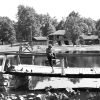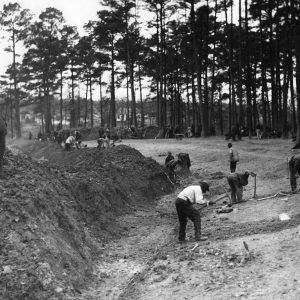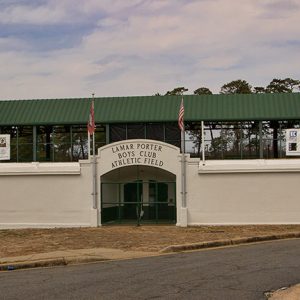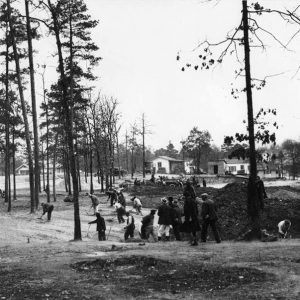calsfoundation@cals.org
Lamar Porter Athletic Field
The Lamar Porter Athletic Field has a regulation baseball field featuring a steel-beam-supported, poured-concrete grandstand built by the Works Progress Administration (WPA). It stands in its original location as the earliest site associated with the Boys’ Club in Little Rock (Pulaski County). It was listed on the National Register of Historic Places on December 6, 1990.
The Boys’ Club movement started in 1860 with the founding of the Dashaway Boys’ Club, which provided supervised after-school activities and leadership training for disadvantaged boys in Hartford, Connecticut. Such clubs are nonsectarian in control, leadership, and membership, and are typically located in or near densely populated areas. Membership fees are kept low so that no child will be turned away from lack of money.
Little Rock’s Boys’ Club has its roots in a “Newsboys’ Club” founded around 1912 when a group of young men led by T. J. Craighead used local Young Men’s Christian Association (YMCA) facilities on Wednesday nights to help local “heroes of the streets” seek better lives. Up to 150 “urchins” showed up to use the YMCA facilities most Wednesdays. Craighead, the first executive director of the Little Rock Boys’ Club, remained active in the organization throughout his life, finally retiring as a regional director in 1959. The “Newsboys’ Club” then became the “Citizenship Club,” a group dedicated to “bettering street boys of the city,” and the Little Rock Boys’ Club developed from this organization.
The Little Rock Boys’ Club officially began on July 14, 1914, when an organizational meeting was held. After the club was organized, volunteer workers sought to befriend members of the gangs of youth in Little Rock. The youngsters were initially suspicious but gradually came to accept membership in the club and to invite their friends to take part in activities.
One of the noteworthy events of the early years of the Little Rock Boys’ Club was construction of the Lamar Porter Athletic Field. Born on August 17, 1913, Lamar Porter was educated in Little Rock’s public schools, attended Little Rock High School, and graduated from Sewanee Military Academy in Tennessee in 1931. Porter was a junior at Washington and Lee University in Virginia when he was killed on May 12, 1934, in an automobile accident.
The land for the ball field, which is located in what was then western Little Rock, was donated to the Little Rock Boys’ Club on the first anniversary of his death, which fell on Mother’s Day. The donors were Porter’s mother, his aunt, and his brother.
The ten-acre plot is bordered by Capitol Avenue on the north, Brown Street on the west, Johnson Street on the east, and 7th Street to the south. It is located in an area that was targeted for park purposes in a 1930 planning survey by John Nolen, a nationally renowned city planner and landscape architect who was dismayed by the lack of recreational facilities in Little Rock. It lies about one mile from the 1936 population center, which Nolen said was located at 12th and Battery Streets. When the donation was made, the Little Rock Boys’ Club served 2,554 boys, as well as 739 girls who were granted use of the facilities at certain times.
Construction on the complex by the federal WPA began in the fall of 1934 and took eighteen months. It took 400 workmen several weeks to clear trees, stumps, and underbrush from the wooded site; a permanent crew of 100 workmen labored on the project the remainder of the time. The project was deemed finished on April 22, 1937, though some work still remained. The total cost of the project was $122,244.53; the federal government provided $108,710.82 for the project.
When the complex was complete, it held a lighted softball diamond with underground wiring, four lighted tennis courts, a regulation baseball diamond, a 1,500-seat grandstand with club rooms, shower and locker rooms, restrooms, and a concession stand. The complex was first used by Boys’ Club teams in the summer of 1936; by 1937, it was also being used by City Leagues and American Legion teams.
At the time, the property also held an apparatus area with swings, slides, and jungle gyms; a small children’s play area that included hammocks, small slides, and kindergarten tables; a play area for older children with facilities for handcrafts and quiet games; and other areas with courts for shuffleboard, marbles, horseshoes, handball, volleyball, and table tennis, as well as picnic areas and a stage.
Throughout its history, the Little Rock Boys’ Club produced some excellent ballplayers, including New York Yankees catcher and manager Bill Dickey and Pat Seerey, an outfielder with the Chicago White Sox. Only one, however, played at Lamar Porter Athletic Field—the outstanding Baltimore Orioles third baseman and Hall of Fame member Brooks Robinson.
The Lamar Porter Athletic Field, as the only site remaining from the early days of the Little Rock Boys’ Club, is most closely associated with the roots and history of that group. The field still hosts ball teams today and is owned by the Billy Mitchell Boys and Girls Club.
For additional information:
“Big Playground for Boys’ Club as Memorial to Local Youth.” Arkansas Democrat, May 12, 1935, Society and Clubs Section, p. 9.
“Lamar Porter Athletic Field.” National Register of Historic Places nomination form. On file at Arkansas Historic Preservation Program, Little Rock, Arkansas. Online at http://www.arkansaspreservation.com/National-Register-Listings/PDF/PU3310.nr.pdf (accessed November 30, 2020).
“Lamar Porter Athletic Field, Gift to Club in Tribute to His Memory.” Arkansas Gazette, May 12, 1935, p. 15.
“Lamar Porter Field Completed.” Arkansas Gazette, April 23, 1937, p. 21.
Silva, Rachel. “Pulaski County in the National Register of Historic Places: A History of Lamar Porter Athletic Field.” Pulaski County Historical Review 57 (Fall 2009): 110–113.
“Will Organize Boys’ Club Tonight.” Arkansas Democrat, July 14, 1914, p. 4.
Mark K. Christ
Arkansas Historic Preservation Program
 Early Twentieth Century, 1901 through 1940
Early Twentieth Century, 1901 through 1940 Historic Preservation
Historic Preservation Recreation and Sports
Recreation and Sports Drainage Operations
Drainage Operations  Lamar Porter Athletic Field
Lamar Porter Athletic Field  Lamar Porter Field
Lamar Porter Field 



Comments
No comments on this entry yet.